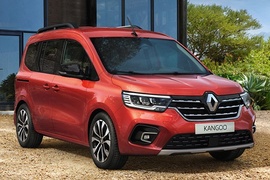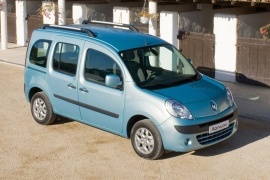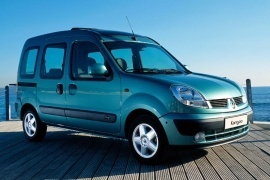
RENAULT Kangoo
Generations Timeline, Specs and Pictures

Renault introduced the Kangoo 4x4 in 2001 and was the only vehicle of its kind on the European market, and in 2006 it was refreshed again along with the rest of its 2WD siblings.
While Renault refreshed the normal Kangoo range for the 2005 model, the 4x4 version had to wait a little longer. It was more challenging to make it Euro 4 compliant than the rest of the stable. Its higher ground clearance and all-wheel-drive transmission affected its engine emissions. Due to that, the carmaker had to install only the gasoline engine in it.
From the outside, the Kangoo 4x4 was taller than its siblings. Its increased ground clearance and black plastic bumpers and side sills made it look different. The carmaker made it mainly for fleet usage at the start, but private customers became very interested in this product. It was affordable, could cope well with some unpaved roads, and still offered a decent fuel efficiency. Its wide windows and dual sliding doors transformed it into one of the best leisure vehicles on the market. It was a crossover, but a 4x4 one.
Inside, it shared its interior with the regular 2WD Kangoo. Since its price tag was higher than the rest of the range, the carmaker installed a standard AC unit and three individual seats for the rear passengers. A big glass roof was on the options list, and it was straightforward to transform its cabin into a sleeping tent.
Underneath the Kangoo bodywork, Renault installed a Nissan drivetrain carried over from the Qashqai. Its all-wheel-drive system allowed the driver to lock the center differential. The carmaker had to use the 1.6-liter gasoline engine since it could comply with the Euro 4 emissions on the vehicle.

Nicely blending everyday practicality with reduced ownership costs, the Renault Kangoo was one of the best-selling and in Europe.
With the first model launched in 1997, the 2020 Kangoo was the third generation, however, it was based on the Kangoo version launched in 2008.
Available as a standard-length van or a long-wheelbase van, the latter was equipped with an optional second row of seats.
A special model was also offered, a more rugged Kangoo that was good for a bit of mud with a mechanical slip differential, underbody protection and a higher ground clearance.
The regular Kangoo was available in two trim levels, the Business and the Business +.
For 2020, the Kango was available with a choice of three different engines and even an all-electric motor that developed 60 hp.
The van drove well, with a light and responsive steering, however, the ride was rougher than the ones offered by other models on the market.
The cabin offered a decent amount of room, the controls were smartly and intuitively placed, however, it was rather a dull cabin, at least without the 7-inch touchscreen that was available with the R-Link multumedia system.
While the base model offered a DAB radio, electric windows and a height-adjustable steering wheel, the Business + trim level added air-conditioning, rear-parking sensors, electric folding mirrors, 15-inch alloys and body colored bumpers.

The last generation Renault Kango was introduced in early 2008 while the sales were started during the same month.
This new model comes with only a few design improvements but with new and more powerful engines which now rang between 1.5 dCI and 1.6 16V. This time, the top engine is a 1.6-liter 16V which produces 110 horsepower and a maximum speed of 105.6 mph combined with a 0 to 100 km/h acceleration done in 13 seconds. However, taking into consideration that Renault Kangoo is actually a mid-size MPV, the performances of these engines are quite acceptable and closer to its rivals, including Citroen Berlingo.

Renault prepared its Kangoo lineup to comply with the Euro 4 Emission regulations and introduced a refreshed version for it in 2005.
When Renault introduced the Kangoo lineup in 1999, the market was surprised. The French carmaker was already known for its range of minivans, and the introduction of an LCV-based MPV was something unexpected. Still, the carmaker used its experience in both areas, MPVs, and LCVs, and came with clever solutions.
When the first Kangoo showed up, everyone noticed its standard sliding door on the driver’s side and the option for another one on the passenger’s side. But its front fascia looked so sad that only those who really needed a car with Kangoo’s abilities bought it. For families, it was not a great deal. Along with the facelifted 2003 version, Renault introduced standard sliding doors on both sides and finally refreshed the front fascia. Its new, tear-shaped headlights completely changed the car’s look, and the carmaker didn’t see any reason not to keep them.
Inside, even though Renault claimed that it improved the interior, those improvements were available only on specific trim levels. For the rest of the range, there were less important changes.
But the carmaker made the most important upgrades under the hood. It introduced the 16-valve 1.2-liter gasoline engine that provided 75 hp and eliminated the 60 hp version, available with a four-speed automatic transmission. The other gasoline engine was a 1.6-liter 16-valves unit that produced 95 hp. For the diesel versions, the carmaker kept the 1.5-liter turbo-diesel unit available with 60, 67, and 84 hp, respectively.

After six years on the market, the Kangoo received a well-deserved facelifted version for its both shapes, as a van or as MPV.
In 1997 Renault introduced the Kangoo range as a light commercial vehicle or as a passenger car based on the same platform as the Clio, but with a longer wheelbase. Its rounded shapes and practical construction made it a good choice for families that needed a bigger trunk. But over time, it started to look old and needed an upgrade. That came in 2003 along with the facelifted version, which included new powerplants and options.
From the outside, the most striking difference was at the front, where the carmaker installed the chromed rhomboidal badge on a body-colored slat in the middle of the grille. Its new headlights received a tear-shaped design, with clear turn signals at their bottom. Renault included two sliding doors in the package, making the ingress and egress much easier for the middle seat passengers. At the back, Renault offered an option for side-hinged doors or a single, wide liftgate.
The interior received some upgrades. Despite being based on a utility vehicle, Renault installed an instrument panel that sported white dials and red needles for the speedometer and tachometer. It applied the same treatment for the coolant temperature and the fuel-level gauges. For even more relaxing drives, the carmaker added an AC unit and a sunroof for the vehicle.
Under the hood, the Kangoo offered a choice of three gasoline and three turbo-diesel engines paired with five-speed manual gearboxes.

Designed for use in the construction sites or just as a leisure vehicle, the Renault Kangoo 4x4 was launched in 2002 and it could have been considered as a cross-over among the utility vehicles.
In the late ’90s, Renault launched the Kangoo as a compact-sized utility vehicle. It was also available as a passenger vehicle, highly appreciated due to its huge trunk and easy access to the rear seats due to its sliding doors. The high demand for the car was, somehow, unexpected in both versions. In 2001, Renault decided to offer it as a 4x4 version, but only as a passenger vehicle.
The 2002 model was late to the party since the facelift for the Kangoo was already scheduled for 2003, but that didn’t matter too much for the French car-maker. It considered that if the car would be sold, will be continued after the facelift. And it was well-received by the market. Its short front, with rounded forms and curved surfaces, was appreciated by its customers. The car offered very good visibility all-around, due to its high seating position and very high A-pillars. Unlike the rest of the range, the 4x4 version was offered with higher ground clearance and special plastic protections around and under the car.
Inside, the Kangoo 4x4 featured numerous storage locations, including over the windshield and on top of the rear doors. With the rear seats folded (or removed) the rear part of the car could have been transformed into a flat platform, great for camping.
Under the hood, the Kangoo was available with a choice of gasoline or turbo-diesel engines. All versions were mated to a standard 5-speed manual transmission.

Unveiled in 1997, Renault Kangoo is a mid-size MPV produced by the French manufacturer Renault but also rebadged by other manufacturers and sold on their domestic markets.
For instance, the Kangoo is also known as Nissan in Latin America and as Kubister in Europe. The Kangoo is assembled in two plants, in Maubeuge, France and Santa Isabel, Argentina. The 1997 version of Renault Kangoo comes with a choice of multiple engines, starting with a 1.2-liter and 1.2-liter 16V and ending with a 1.9-liter dTI and a 1.9d. The top engine installed on a Kangoo is the 1.6 16V and develops 95 horsepower and a top speed of 150.6 mph.























































